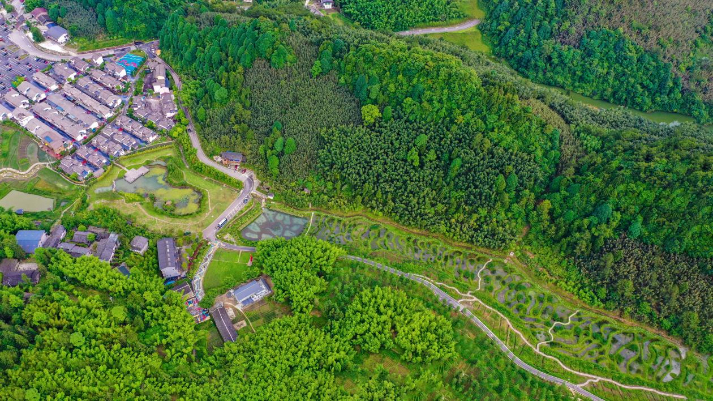Driving up the winding mountain roads of Liangping District in Chongqing Municipality, southwest China, travelers are greeted by slopes covered in dense bamboo forests. The fresh, leafy view hides a painful memory: Just over a decade ago, these same hills were scarred by unchecked pollution from mining and papermaking. Dust filled the air, streams ran dry and villagers recall nights when even the stars were hidden behind a thick haze.
“It had to stop. The water was dirty, the land kept sinking and everything was dusty,” Chen Zongshou, Secretary of the Communist Party of China (CPC) Branch of Lieshen Village in Liangping, recollected.
Shutting down the mines was not an easy choice. For a time, villagers were unsure as to how they could make a living. The district government sent local officials to Yucun Village, Zhejiang Province in east China, known for turning away from polluting heavy industry toward green development, to learn the latter’s successful practices, and invited experts from the Chongqing Association of Homestay Owners to help chart a new path.
Chongqing sits at the upper reaches of the Yangtze River, the longest waterway in China. Its environmental quality directly affects the health of the entire Yangtze valley, home to some 400 million people, and the sustainability of downstream regions. In recent years, the municipality has closed dozens of mines and launched large-scale ecological restoration projects, gradually turning abandoned pits into new sources of growth.
Gains and losses
For years, many mining areas in Chongqing followed the same trajectory: Fast profits at first, followed by steep environmental costs. Lieshen and Zhonghua Village in Beibei District are examples.
Lieshen once relied on what locals called the “bamboo economy” and the “stone economy.” In over 30 years from the early 1970s, more than 400 out of over 530 hectares of bamboo forest in the village were cut down to supply raw materials for papermaking. Later, the discovery of high-quality gypsum made mining the backbone of the village’s economy. The boom brought short-term income but left long-term damage, resulting in a landscape of pockmarked hillsides and clouds of dust where bamboo forests once stood.
Zhonghua, nestled in the Huaying Mountains, suffered a similar problem. Rich in limestone, it became a quarrying hub in the early 2000s, when demand for building materials was soaring. For over a decade, machines thundered day and night, rocks piled high across the landscape. The environment deteriorated rapidly.
The hill above Zhonghua was torn open by mining, leaving a pit with a surface area of 20 hectares and a depth of dozens of meters. Dust covered homes and farmland throughout the year, and the village’s landscape and ecosystem were severely damaged.
Transformation in motion
The turning point came in 2016. That January, a high-level meeting on advancing the development of the Yangtze River Economic Belt, comprising 11 provincial-level regions along the Yangtze and accounting for nearly half of the China’s population and GDP, took place in Chongqing. The Yangtze was described as a lifeline for national development, and the message was clear: Ecological protection is a top priority. “Protect; don’t over-develop” became the guiding principle. Against this backdrop, and under mounting
environmental pressure, Chongqing began shutting down mines and launching large-scale ecological restoration projects.
By 2017, Zhushan Town, where Lieshen is located, had decided to abandon nearly two decades of reliance on mining. The town closed all its quarries and designated an ecological protection zone. In Lieshen alone, five gypsum mines were shut down, and 65 gaping mining pits and collapse zones have been rehabilitated from then on. Engineers and villagers turned them into a chain of terraced mountain wetlands, making use of the natural slopes and streams.

Zhonghua faced an even tougher challenge. Its economy had depended almost entirely on quarrying. Among those who took on the task of restoration was Zhou Song, a university graduate who returned home to help—and who also happened to be the son of a former mine owner. “Planting trees on a mine is harder than mining itself,” Zhou said. The soil was thin, so he and his workers began hauling back earth that had been stripped away.
To give the fruit trees a chance to survive, they filled each pit with twice the usual amount of organic fertilizer. On the bare, rocky cliffs, they used excavators to spread soil before planting. Slowly, the barren slopes began to change.
Today, the landscape has taken on a new look. In spring, peach, plum and rapeseed flowers blanket the hillsides. In summer, harvests of peaches, plums and watermelons bring good income for farmers. Once a riddled minefield, now reborn.
Green is gold
“Mine restoration in Chongqing is not just about ‘greening the affected areas.’ It’s a campaign that integrates ecological benefits, industrial development and improvement of living standards,” Zhang Deqiang, a senior expert at the China Geological Environment Monitoring Institute, said.
In Lieshen, that vision has become reality. According to Chen, shutting down the mines forced the community to rethink its economy. The solution was a path of “diversified development.”
Villagers began cultivating bamboo fungus—a mushroom that grows on bamboo roots and is popular in Chinese cuisine for its health benefits. They also expanded bamboo shoot farming and bamboo-product processing, creating a “green cycle” that uses bamboo to sustain bamboo.
Local companies partnered with the village to build wellness resorts and homestays, launching a tourism brand centered on Lieshen’s status as a year-round vacation attraction.
Tourism brought in visitors, and with them, demand for restaurants and cafés. Villagers converted idle houses into “bamboo homestays” and farm-to-table eateries, turning natural beauty into what locals call a “beautiful economy.”
The results have been dramatic. Lieshen has become a popular destination among young travelers, its scenery lending itself to the perfect social media photo. In 2024, the village welcomed over 300,000 tourist visits, generating more than 60 million yuan ($8.3 million) in tourism revenue and creating over 300 jobs. “With the environment restored, wellness tourism and the bamboo economy are filling people’s pockets,” Wu Daxiong, Secretary of the CPC Zhushan Town Committee, said.
Zhonghua has followed a similar path. Its former mining areas are now fruit orchards, with more than 18 hectares of peach, plum and watermelon.
Zhou, the returned university graduate with a background in architecture, converted several old family homes into the Jibai homestay, which now employs nearly 30 villagers, many of them former miners.
As the Jibai brand grew, the village introduced a weekend market where farmers can sell produce directly to visitors. A local cooperative set up a millet-processing workshop, turning local grains into specialty items like millet wine and snack packs that serve as popular souvenirs. This model has gradually transformed Zhonghua from a mining site into a showcase of integrated agriculture, culture and tourism.
Looking ahead, Zhou has bigger plans. “We are working to launch Chongqing’s first vocational certification program for homestay managers here in Zhonghua,” he said. “That way, we can train more professionals for the industry and export service standards, therefore helping more people join the effort to translate our ecological value into real economic benefits.” –The Daily Mail-Beijing Review news exchange item






